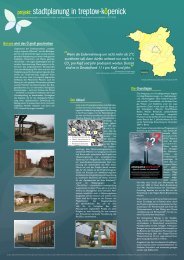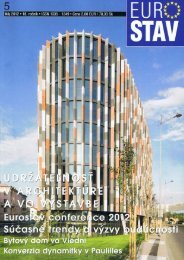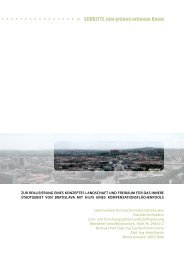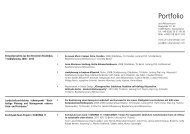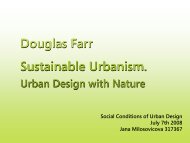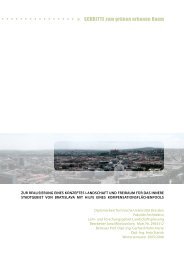However, greening of surfaces and albedo rising are not the only aspectsthat significantly influence the energy balance of cities. The naturalwater cycle and (rain)water management are another issues to beconsidered when pursuing climate-sensitive urban design.“Water and water vapor influence inthe most significant way the climate onEarth” (Kravčík et al. 2007, p. 14).Water cycleIn the natural environment, about 75% of rainwater evaporates fromthe land and thus stabilizes the climate and the temperatures. In urbanareas however, as pointed out before, the lack of evapotranspiration isa major cause of the urban heat island – and thus the evaporation ofrainfall should have the highest priority (SenStadt Berlin and TU Berlin,p. 11). The consideration of water – in fluid form or as water vapourincreasing the air humidity – has however been widely underestimatedand overlooked in urban design considerations. In this section, it willbe reported on the importance of water and possibilities of restorationof the small water cycle through urban design.The small water cycle (fig. 17) is characteristic for a hydrologicallyhealthy country, where solar radiation evaporates water from waterbodies, soil and plants into the atmosphere. There, water representsthe largest energy conversion of incoming shortwave solar radiation,playing an important role: “the less water in the atmosphere, theweaker its moderating effect on temperatures” (Kravčík et al. 2007, p.14). The majority of evaporated water in the atmosphere condensesand falls down again at night in the given region or its surroundings –alleviating the UHI effect, whose intensity is most significant at night.In urbanized, built-up areas, there is an extensive disruption of evaporativevegetation cover and of permeable surfaces (fig. 18) and thus,a high proportion of the rainwater is led into the sewerage, instead ofbeing evaporated. “Nearly all rainwater from the cities of Europe is carriedto rivers and eventually to the seas from paved and roofed areasby rainwater sewers” (Kravčík et al. 2007, p. 43-44). To illustrate thesituation in one particular city, only in Berlin it is annually 35 millionm 3 (SenStadt – Rainwater I, online). The effects are a longterm drop ingroundwater supplies beneath the paved and roofed surfaces, a fall inatmospheric humidity and cloudiness 15 and a decrease in light and frequentprecipitation (Kravčík et al. 2007, p. 17-18, 44). All this affectsthe natural water cycle, leads to an increase in urban temperatures andcontributes to other serious problems such as floodings, extreme heatsand droughts (Sass, online). The physical impact of cities on small watercycle might be observed in the figure 19.Fig. 17 The small and large water cycle(Kravčík et al. 2007, p. 20)Fig. 18 Extensive soil sealing in urbanizedareasBuilt surfaces in cities that influence the rainwater runoff have a dramaticimpact on the water cycle (fig. 20). In the table below, we see15 Cloudiness is another important aspect of a biologically well-working small watercycle. The role of clouds, besides inducing rain, is in the absorption and reflectanceof the global sun radiation. Through clouds, the incoming solar radiation isrestrained and hence the earth’s surface heats up less. In urban environments,poor on water bodies and vegetation, the local evaporation of water, and hencealso the creation of clouds in the adjacent atmosphere, is limited. More solarradiation permeates through the atmosphere and heats the earth’s surface up,rising the urban temperature.Fig. 19 The impact of the transformation ofland on the destruction of small water cycles.Rising radiant air flows pushes clouds to coolerenvironments, where the moisturing and thuscooling precipitation falls on earth. (Kravčík etal. 2007, p. 58)2 Literature review: The impact of built structures on climate, energy flow and the water cycle19
the values of water balance of various surfaces. This gives us indirectlythe information about the warming of the adjacent environment. Byvaporization of 1 kg of water at a temperature of 25°C, 2,243.7 kJ ofheat available from solar radiation are consumed (Kravčík et al. 2007,p. 25). On paved areas, where water runs off the surface or infiltratesdeep into the ground, this amount of radiation will be returned into theatmosphere in form of sensible heat. Thus, the lower the evapotranspiration,the higher the heating up of the surface as well as of theadjacent atmospheric layer (see the runoff values in Table 2):a.Table 2. Water balance of variously-used surfaces in mm. 1.1.2001-31.12.2004, TU Wilmersdorf, Berlin. (SenStadt Berlin and TU Berlin, p. 12)intosewageb.Fig. 20 Hydrologic flows in natural environment(a) and changes in hydrologic flows inurbanized catchments with increasing impervioussurface cover (b) and with widely pursuedinfiltration (c) (Göbel et al. 2004; adjusted),showing that mere infiltration provides highgroundwater recharge but has a dramatic effecton the decrease of evaporation rates.c.The aim in urban design should be to lower the runoff values tothe possible minimum and to infiltrate and particularly evaporate(fig. 20a) rainwater on site or as close to the site as possible – bycreating oveground, opened rainwater catchment basins and byenhancing vegetated areas around and on buildings that use therainwater for evapotranspiration and thus achieve energetic balance thatresembles the balance in rural areas (fig. 21).Another of the negative urbanization aspects observed in cities is themodification of natural water streams and ponds – filling in, enclosure(paving-over) or placing in culverts –, drainaging of the wetland surfaceand thus dramatically reducing the evaporative surface of opened waterbodies and adjacent riparian areas (Paul and Meyer in Marzluff et al.,2008, p. 211). The notion thus should be to re-open and restore the naturalstream channels in order to alleviate the urban temperatures. Themore opened water bodies and the greener the city, the higher latentheat partitioning and thus less sensible heat outflow, lowerheat storage and lower UHI effect (Emmanuel 2005, p. 124).Kravčík et al. (2007) warn that the drying of the continents, significantlyaugmented due to urbanization, is receiving very little public or scientificattention. The researchers insist that the water balance at all20Climate Sensitive <strong>Urban</strong> <strong>Design</strong> in Moderate Climate Zone: Responding to Future Heat Waves. Case Study Berlin Heidestrasse/Europacity



